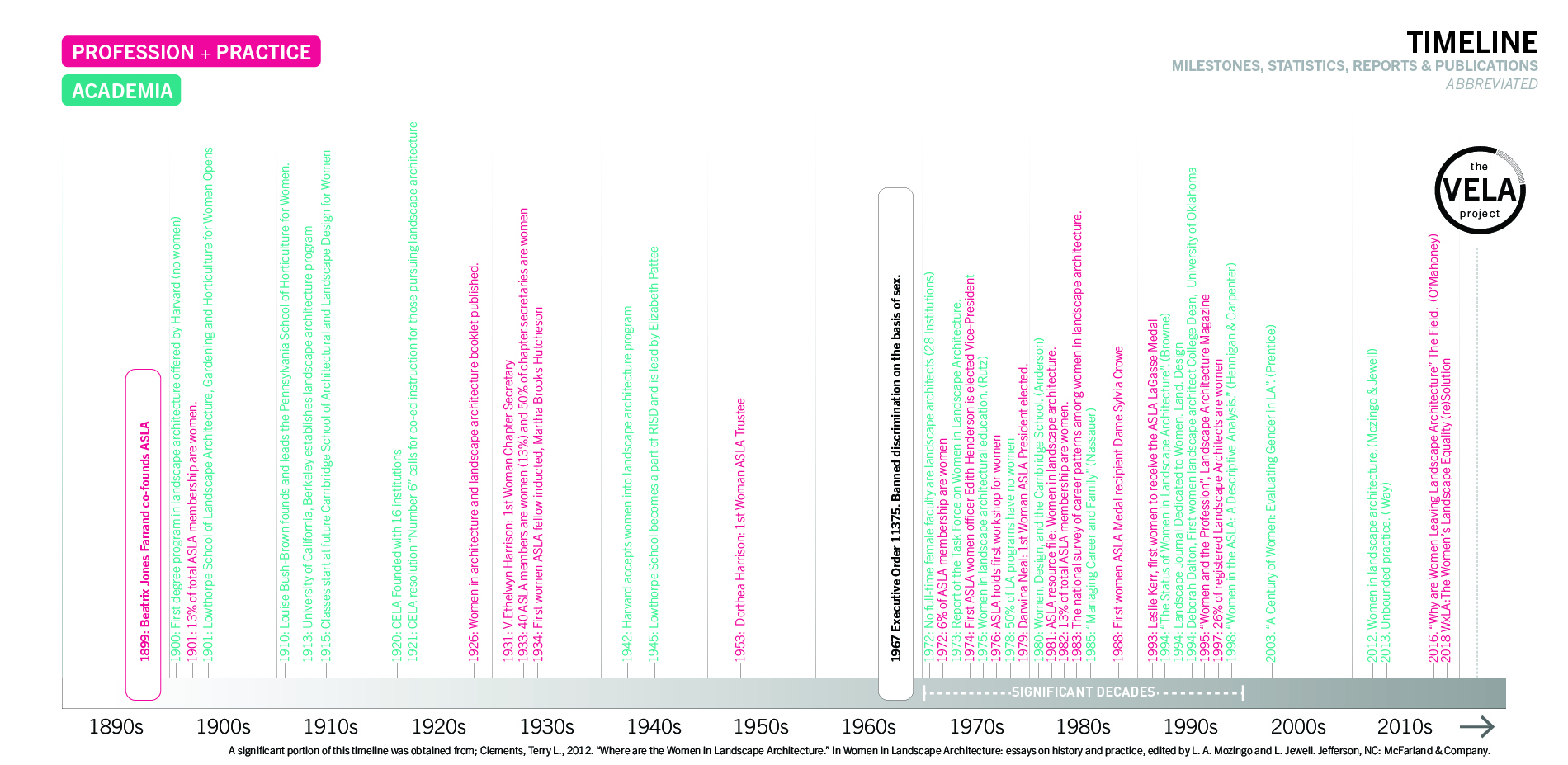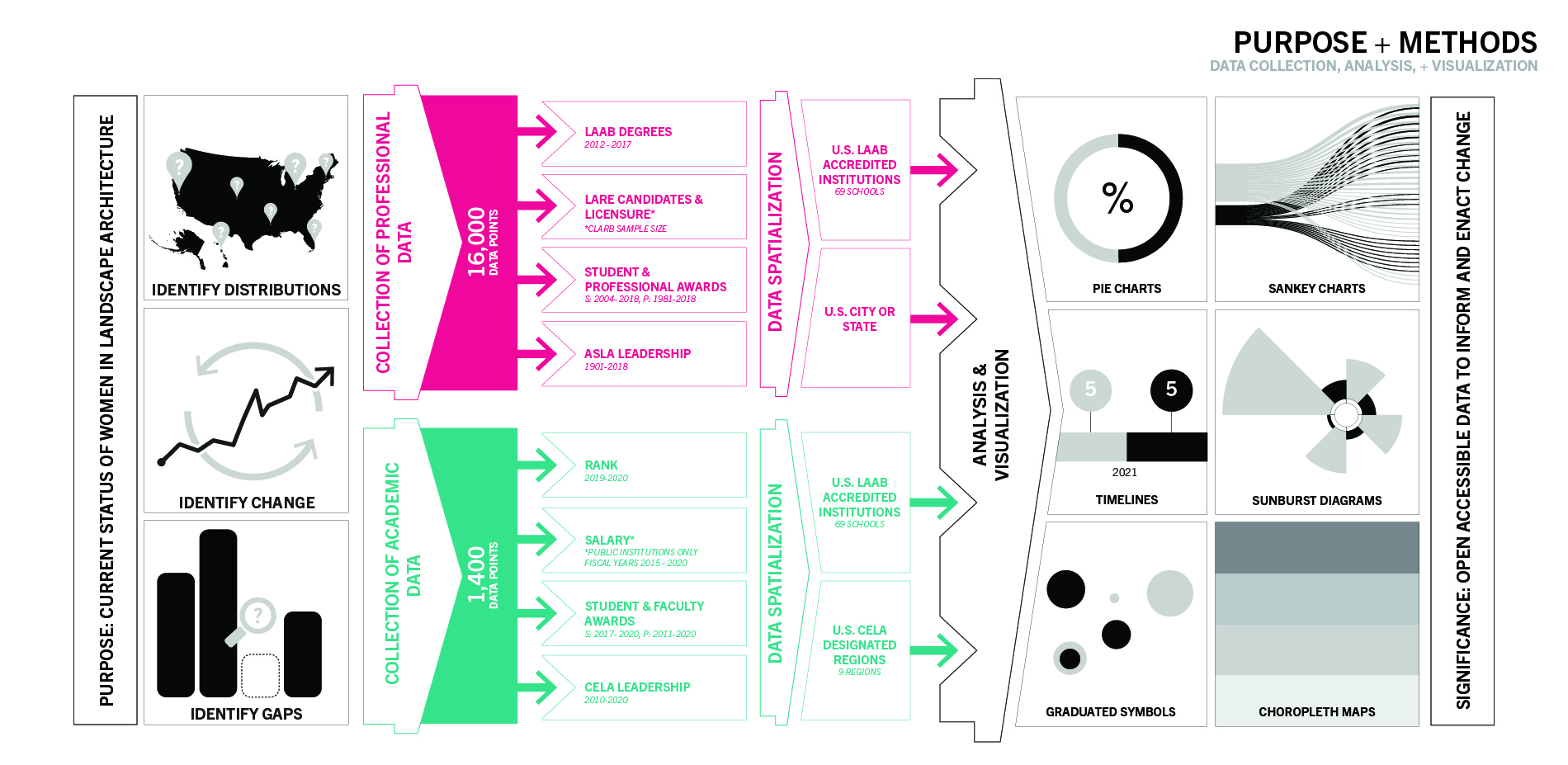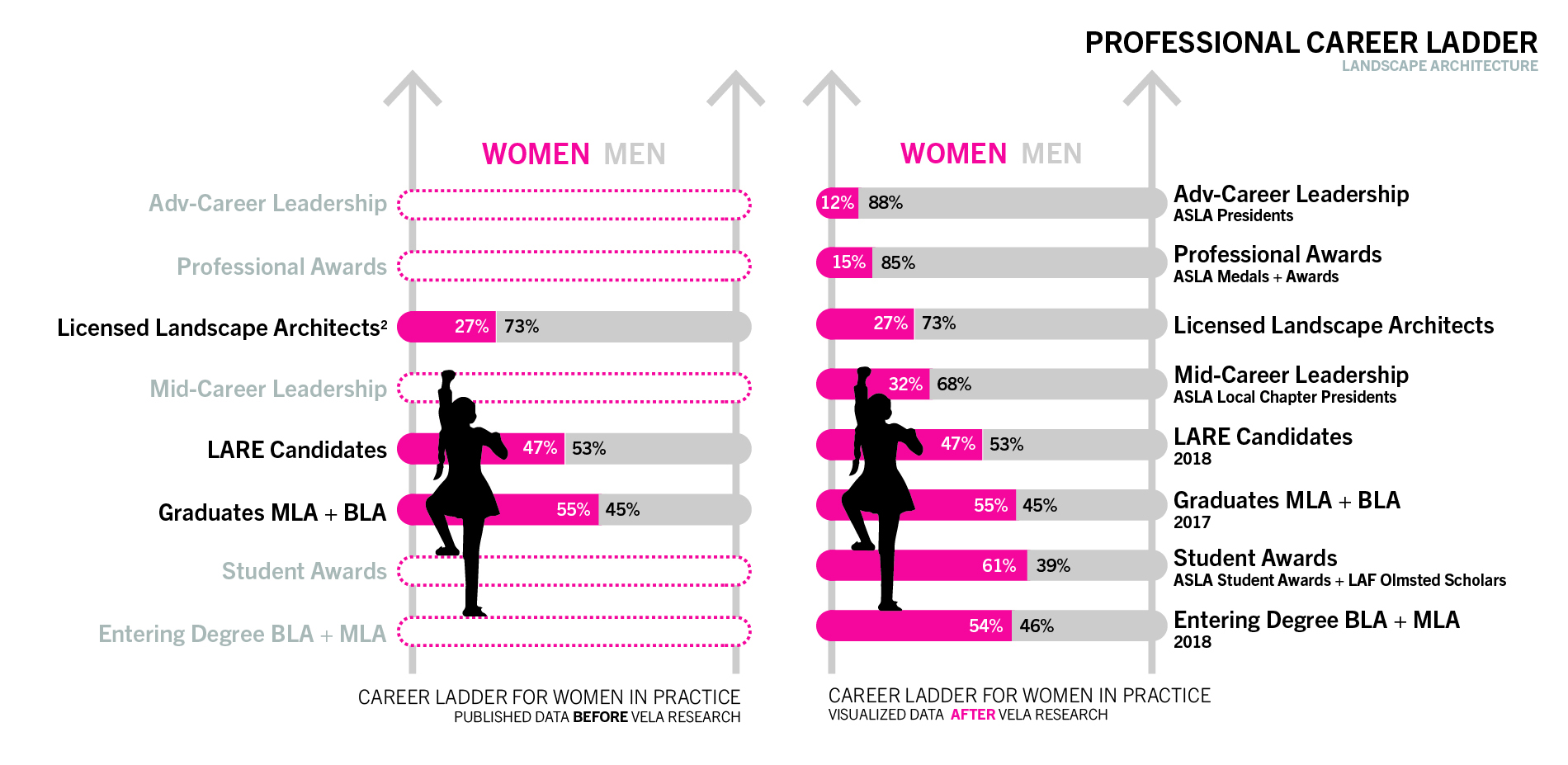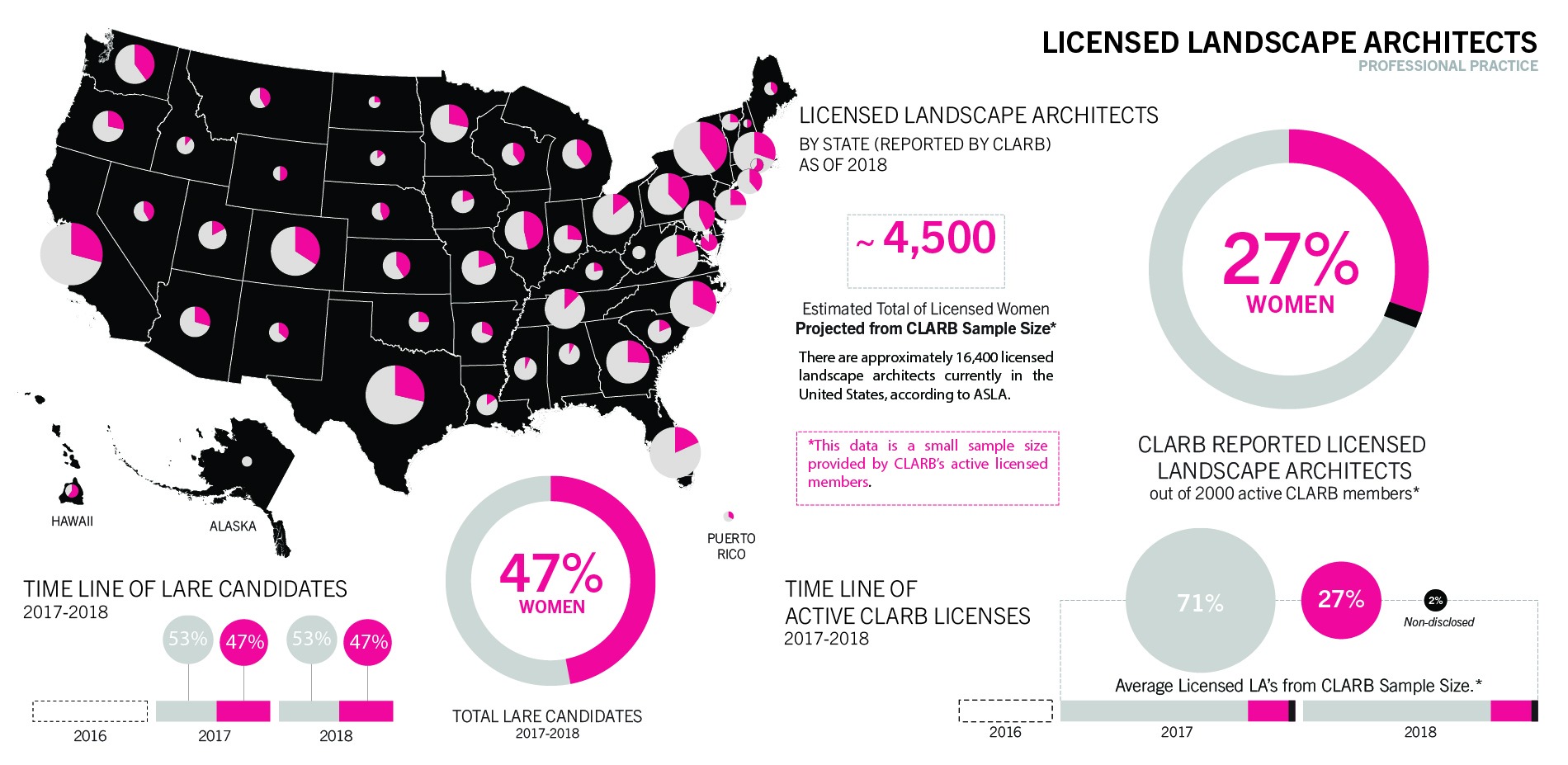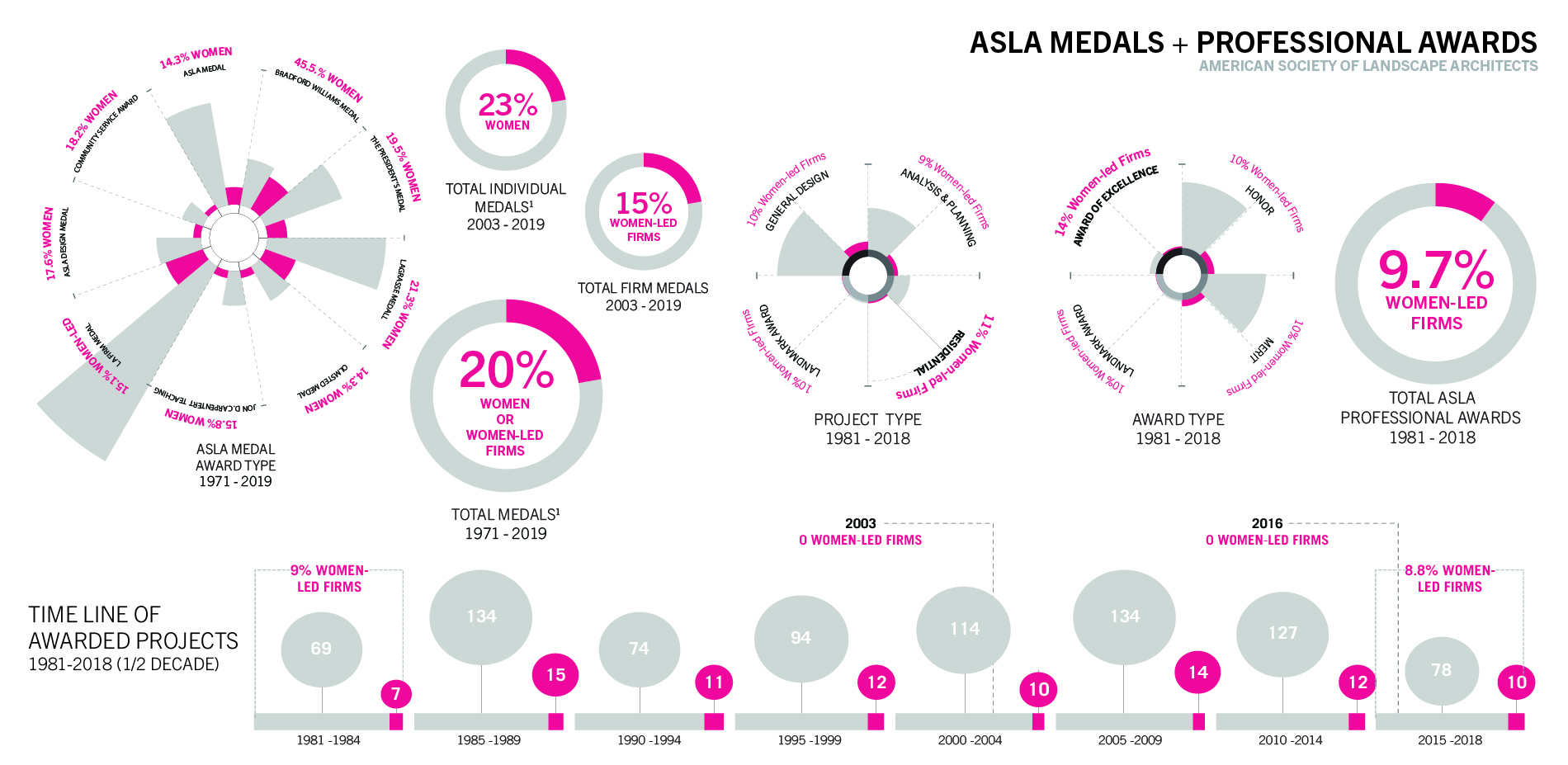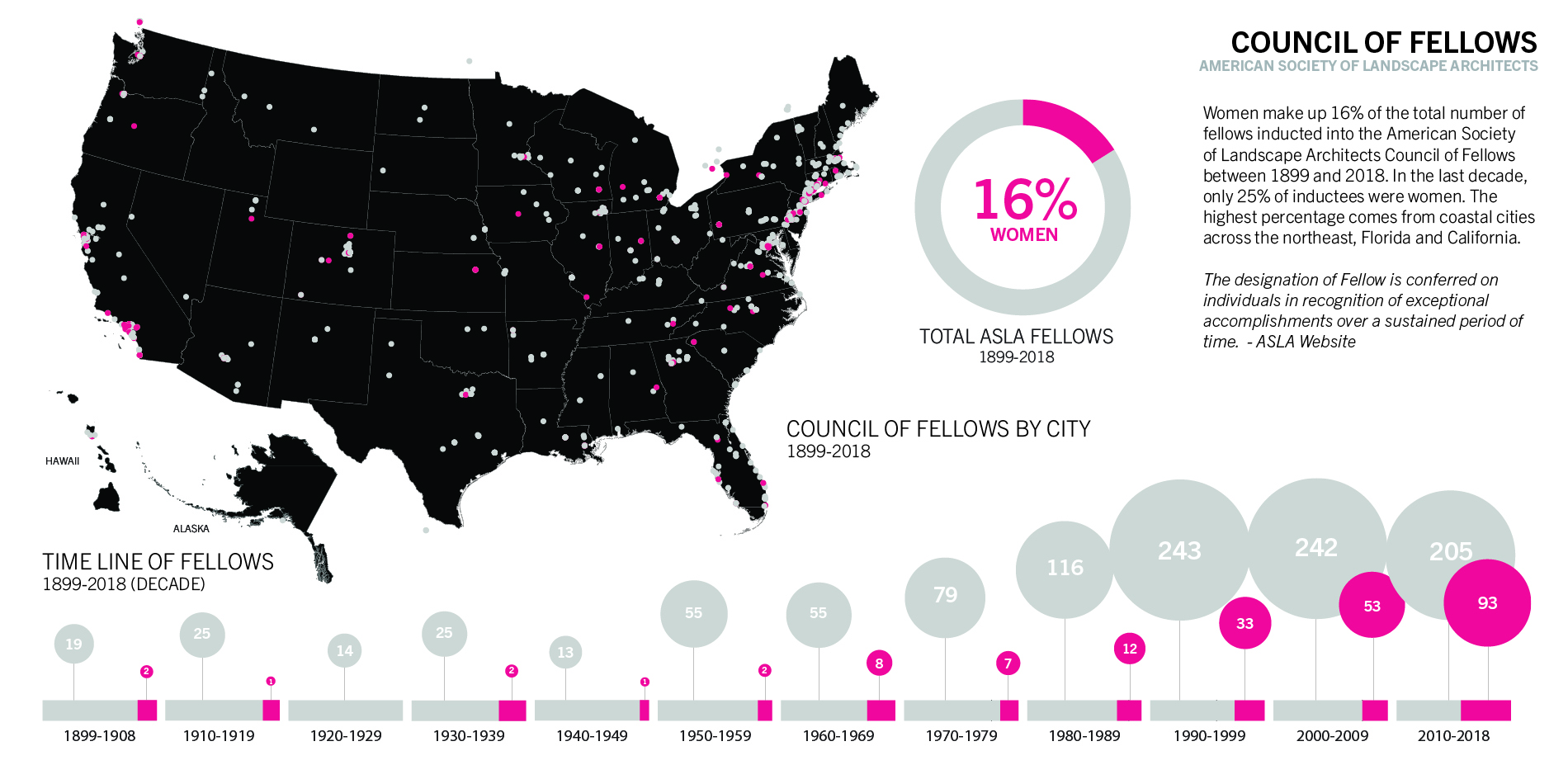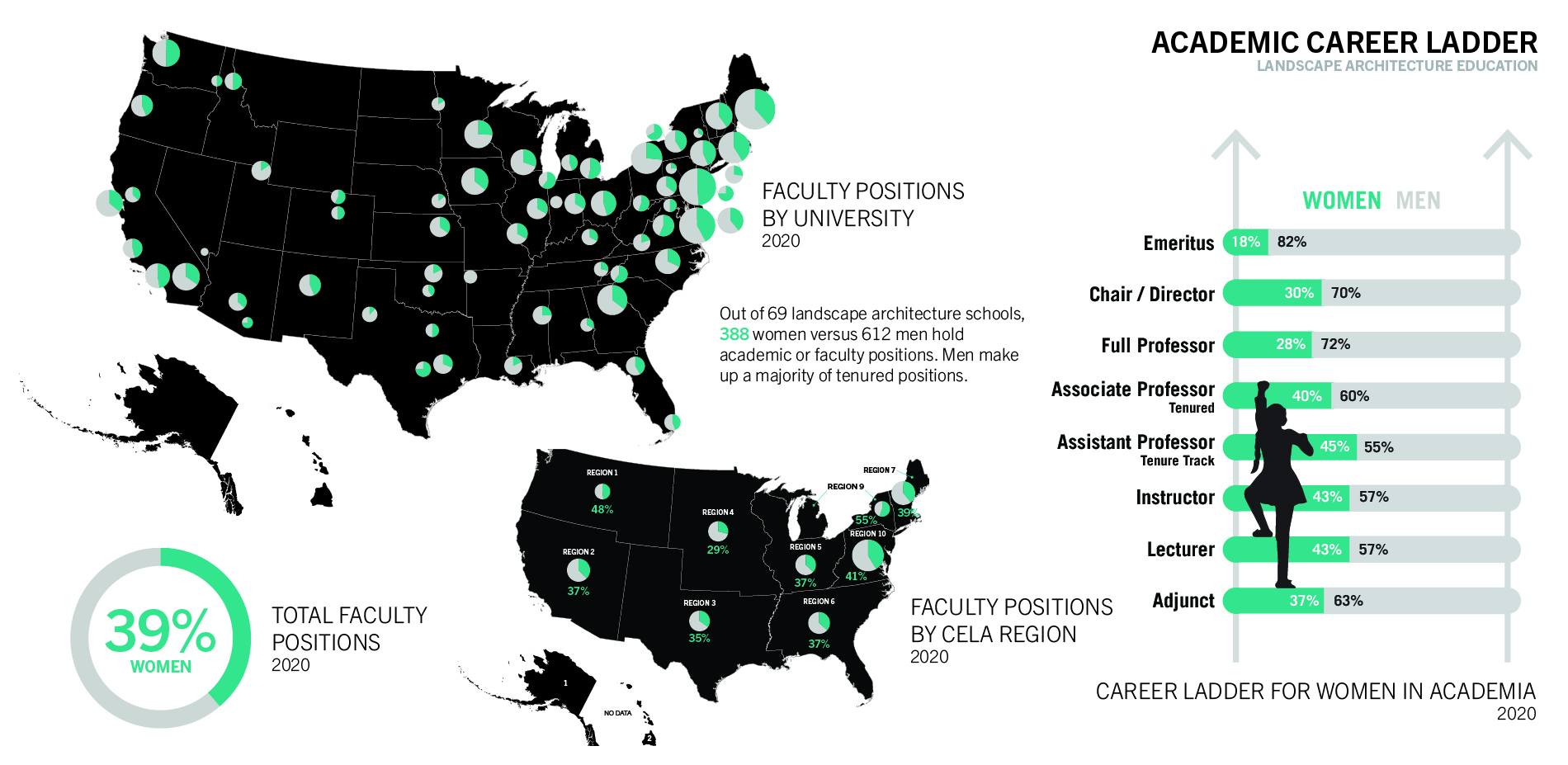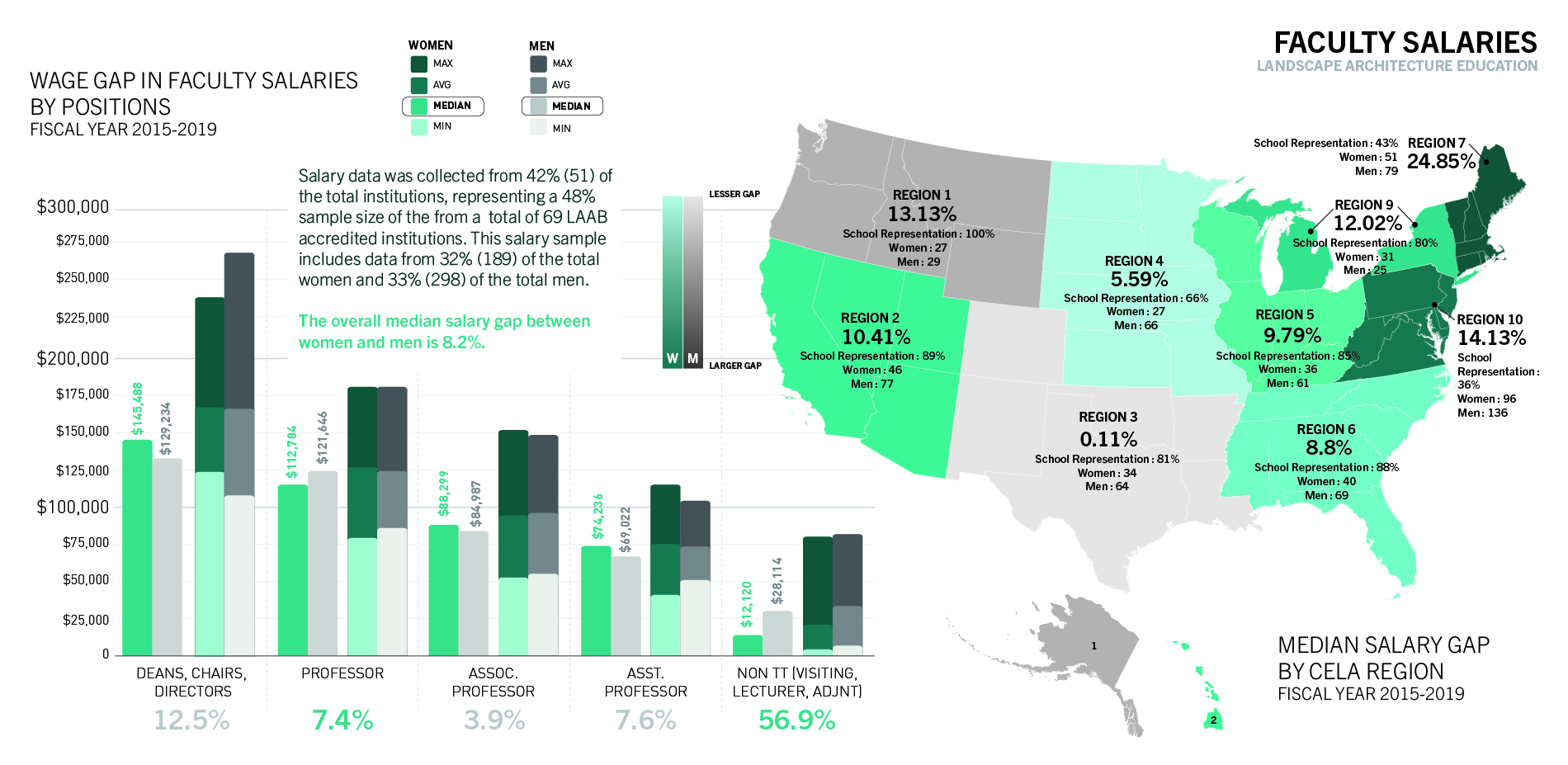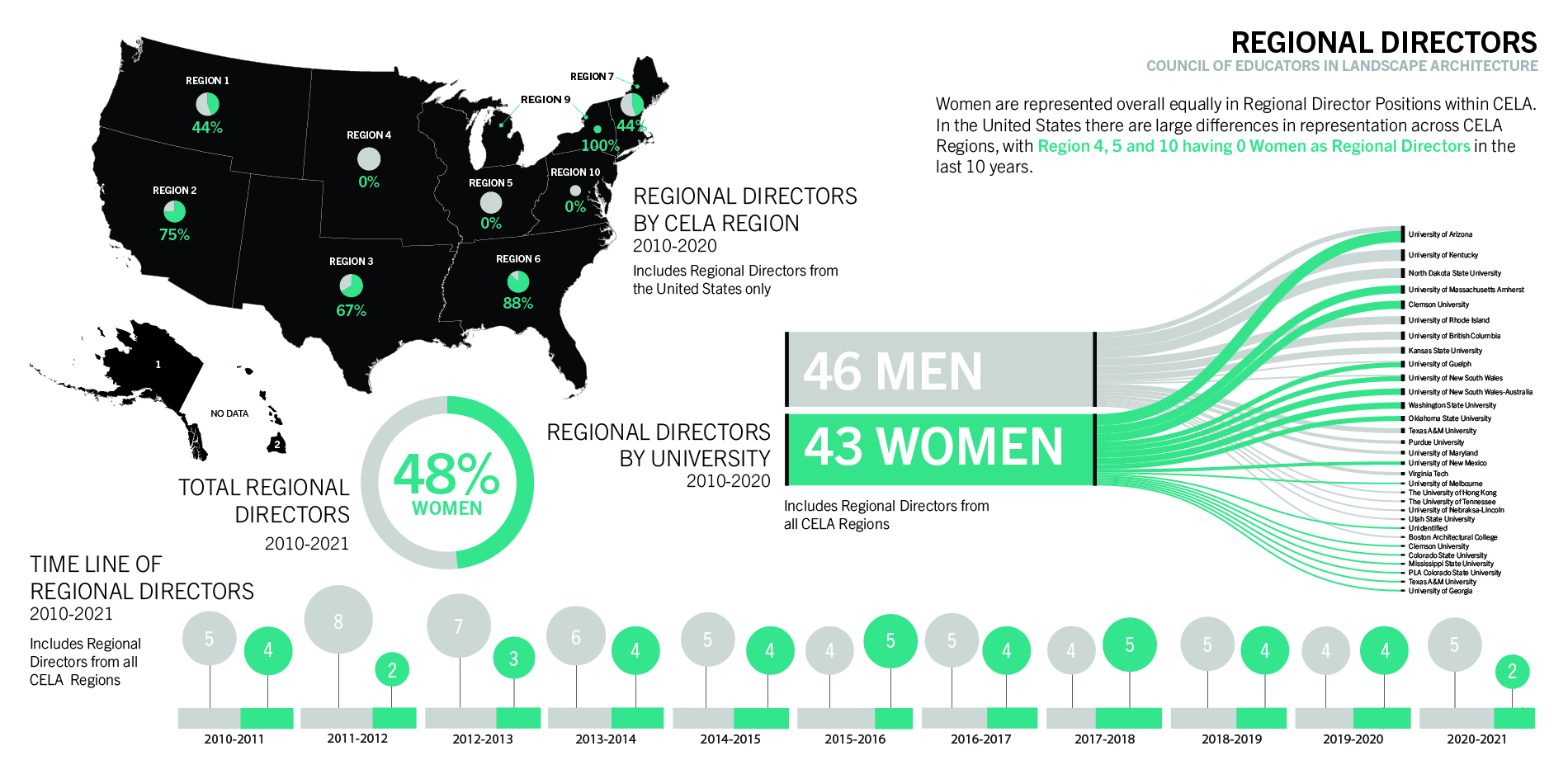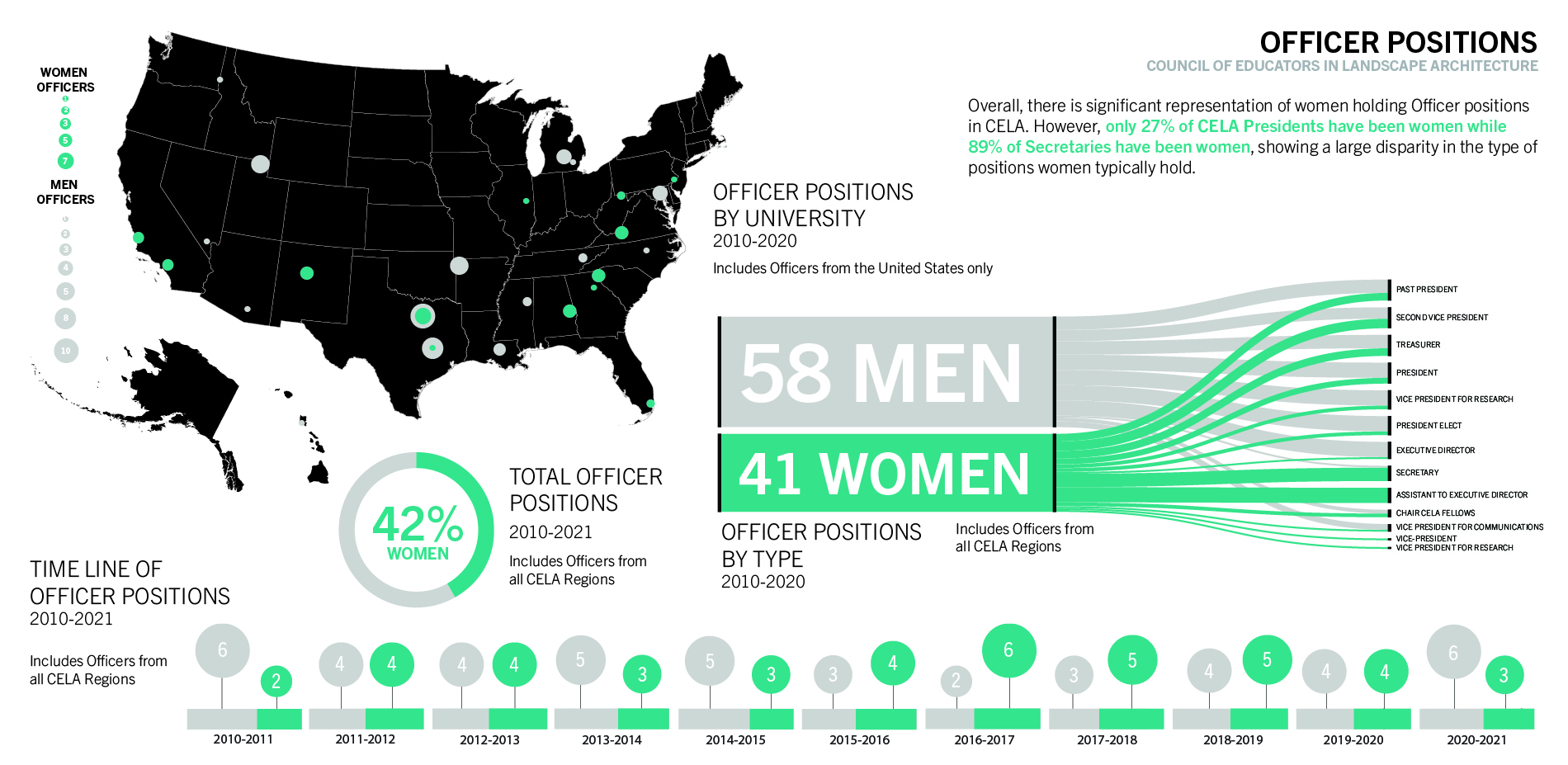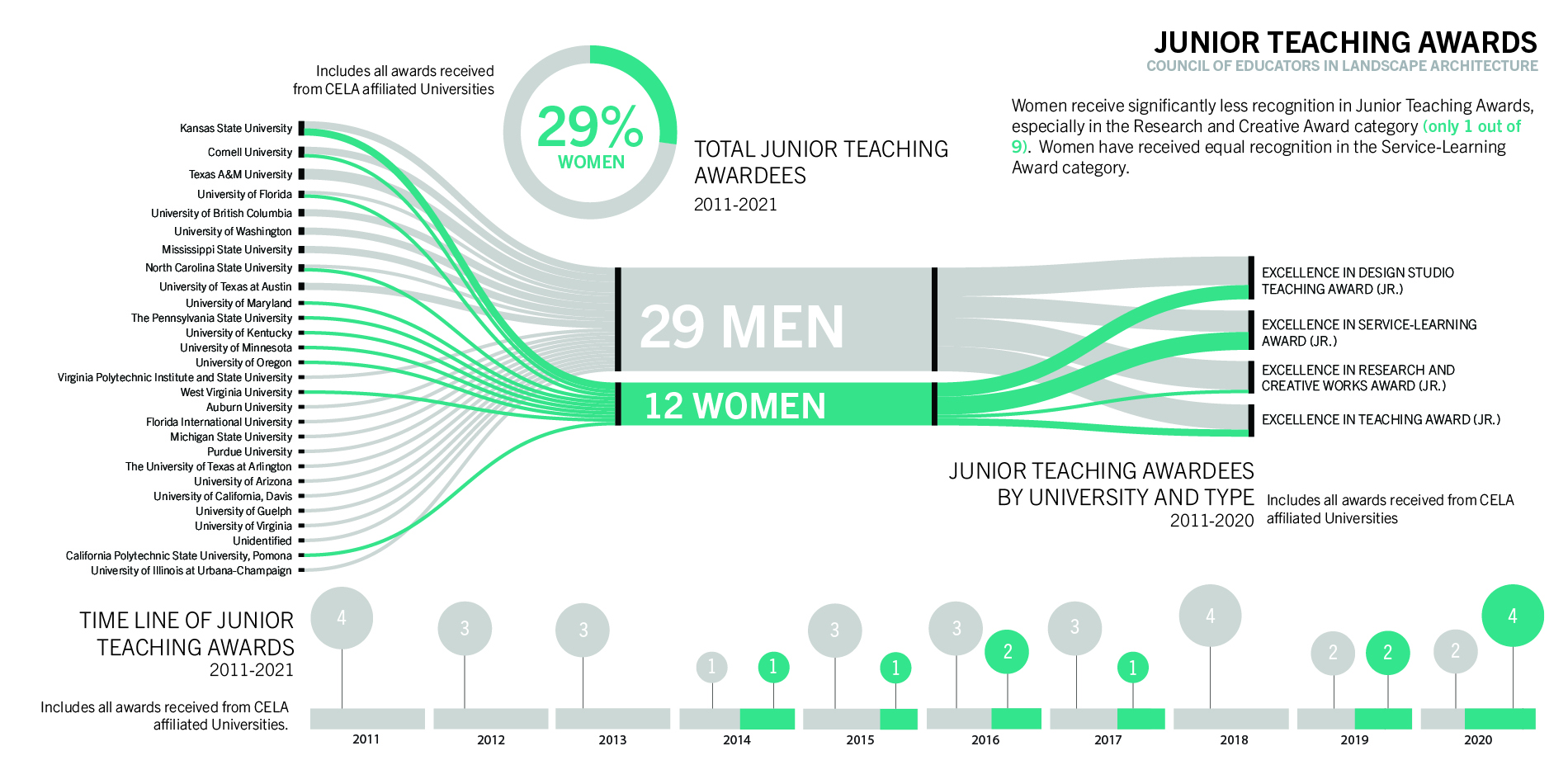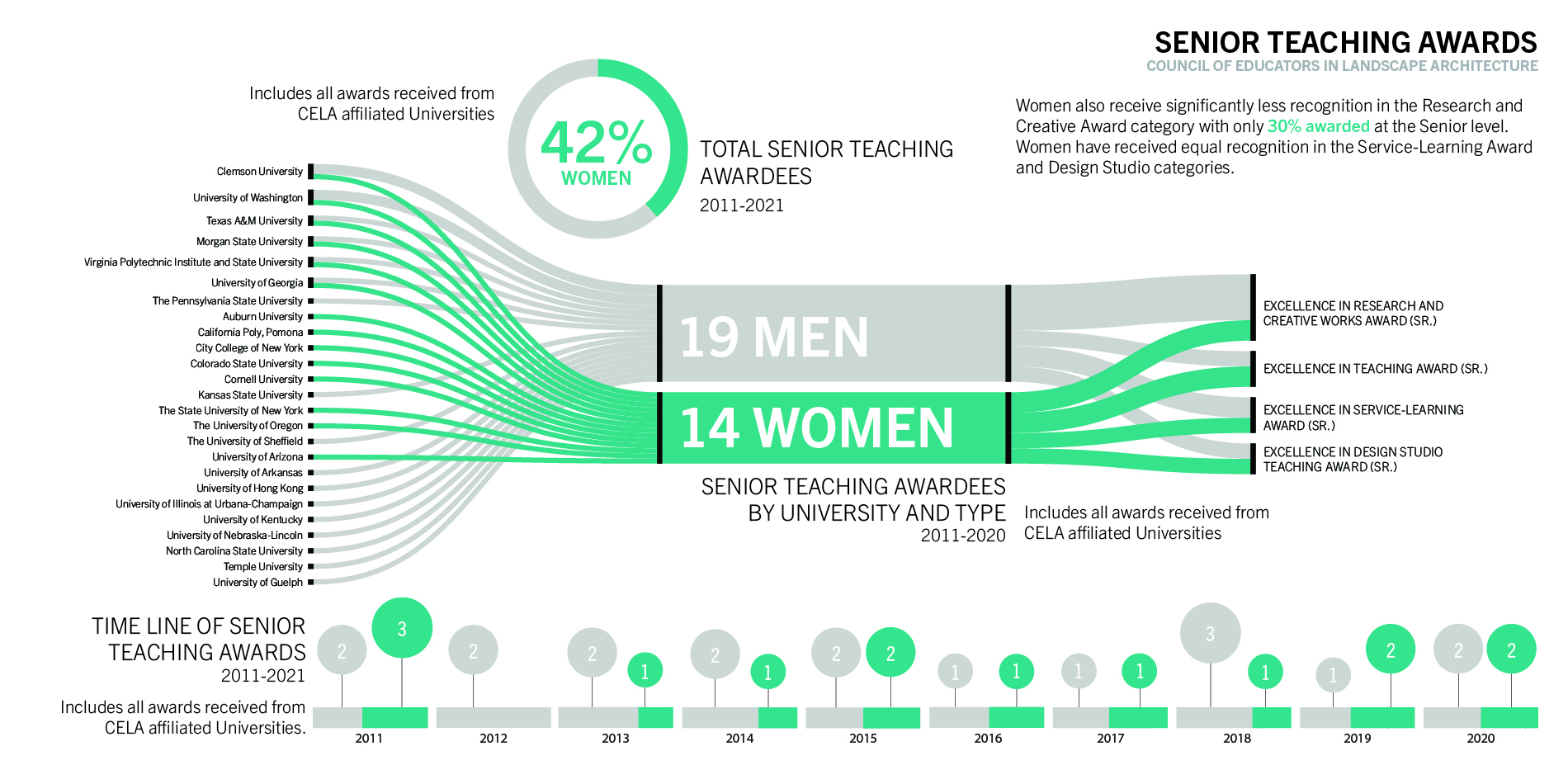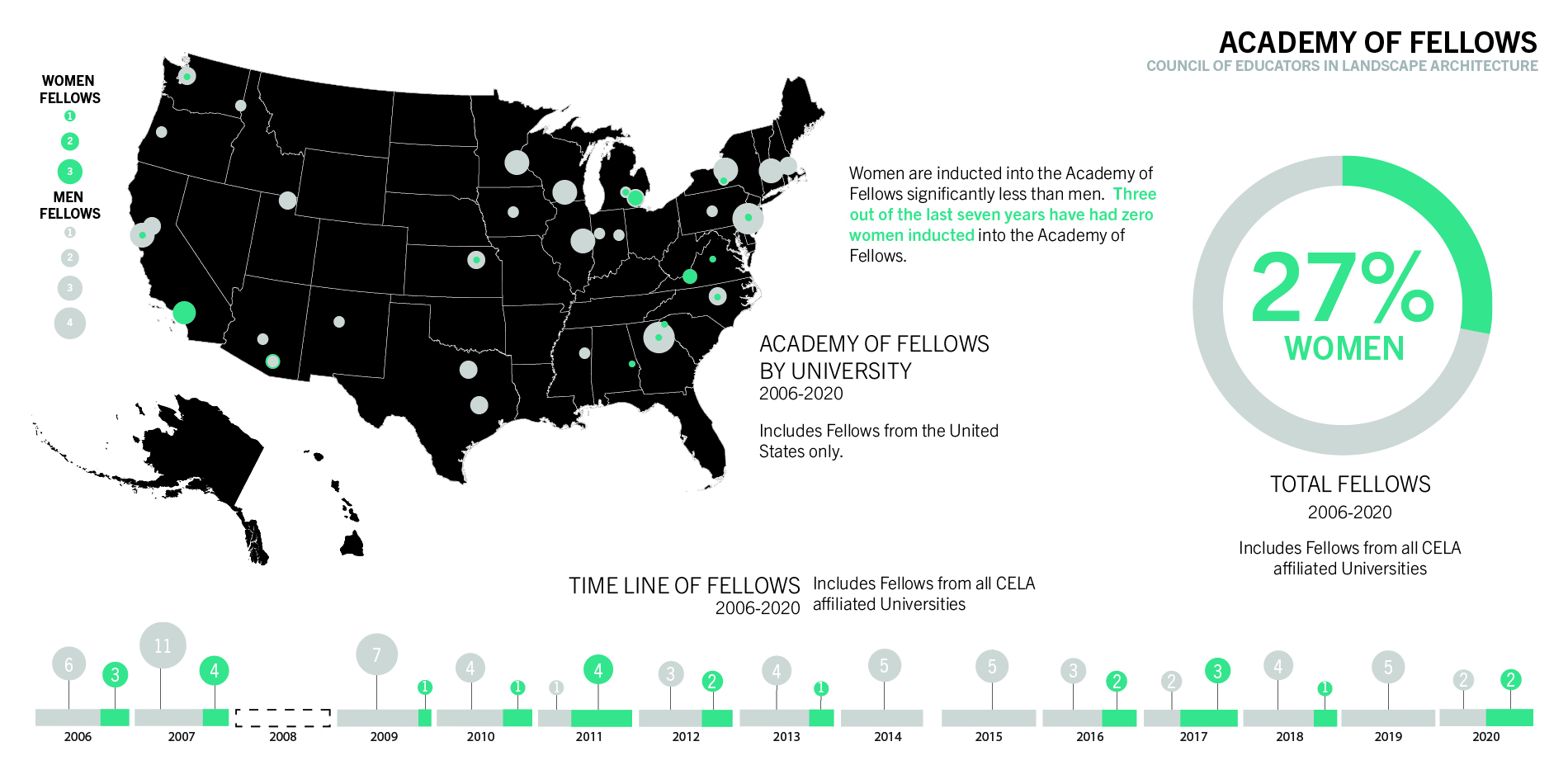The Visualizing Equity in Landscape Architecture Project
Award of Excellence
Research
Inspired by Darwina Neal’s pioneering 1973 report on the state of the field, the VELA Project—Visualizing Equity in Landscape Architecture—updates the profession on the progress of gender equity within both professional practice and academia over the last two decades. Measuring current statistics against those found in Miriam Rutz’s 1975 task force report analyzing the extent of women’s involvement in ASLA, VELA shows significant progress but also additional parity still to be achieved. The study also serves as a reminder that equity approaches beyond gender must be considered to advance the profession, and this award should prompt release of further data to compel action.
- 2021 Awards Jury
Project Credits
Catalina Dugand, Lead Reseacher
Olivia Bussey, Research Team
Alain Carrazana, Research Team
Sheyla Aguilar, GIS Research Analyst
Katja Rocha, Research Team
Mairin Subervi, Research Team
Elizabeth Tran, Research Team
Project Statement
The Visualizing Equity in Landscape Architecture (VELA) Project is a research initiative that reveals, spatializes, and acknowledges the status of gender equity throughout landscape architecture. Over twenty years have passed since the last report documenting women's careers in landscape architecture. The issues raised then are similar to many problems women face now. To understand why these disparities still exist and the gaps associated with them, the VELA project offers a current review of women's status in both academia and the profession. The research collected over 17,000 unique data points from multiple public sources. The analysis organizes the data into a series of robust visualizations that catalog current trends and highlight opportunities to improve gender equity in the profession. The purpose of this research is a question of value—to recognize where "we" as a profession fall short and where critical re-alignments must occur. The project is a provocative and timely exploration that serves to inform, instigate, and empower the landscape architecture community to rally together and transform the future of practice, now!
Project Narrative
Research Statement
In 1973, Darwina Neal—the first female president of the ASLA—prepared the premier report on women in landscape architecture. Surged by the groundbreaking findings, several subsequent studies throughout the following decades emerged. Each provided critical insights into the status of women in the profession. The last 50 years of literature and reports highlight substantial disparities in licensure and promotion, women-owned businesses, and job discrimination. It has been over twenty years since the last significant study was released, yet women today still face similar issues. With the resurgence of women-based initiatives populating social media channels and conference circuits, the timeliness of having a contemporary dive into the status of women in landscape architecture is imperative.
Unlike previous studies that collected data solely from exclusive membership pools, the VELA Project reveals evidence from open-sourced data, providing a glimpse into less studied areas of academia and professional progression and leadership. The research asks questions across various topics and comparatively maps the overall distribution and disparities found between men and women while revealing how those disparities have changed over time. These categories include; graduates, student awards, licensure, design awards, organizational leadership, faculty rank, faculty salary, and research/teaching awards. The work presents a series of data-driven cartographic visualizations and infographics that are easily accessible to the viewer while providing deeper analysis and reflection opportunities.
Methods
The primary research methods involved secondary data analysis collected from publicly accessible sources and existing data reports. The inventory of data was aggregated into larger datasets that eliminated individuals identification to maintain anonymity in the representation of the results. This process occurred through spatial simplification and data points receiving either a W (for women) or M (for men). This research's organizers acknowledge that specific metrics include bias based on perceived identification of binary gender classifications. After the extensive data collection, the results were organized and then visualized by time, ratio, quantity, and proportion. The results are not only the collected statistics, but the visualizations themselves are the results.
Professional Organization and Leadership Results
The VELA Project collected 16,000 unique data points collected from ASLA, the Landscape Architecture Foundation Olmsted Scholar Program, CLARB data on active members with a council record, and state ASLA chapter websites.
The overall data shows that women dominate in pre-professional narratives. More women enroll in and graduate (55%) with landscape architecture degrees, showing a nearly 10% gain from 2013 to 2017. In the ASLA student awards, women receive more recognition in the Communications, Collaboration, and Community Service categories while the General Design and Analysis and Planning categories have almost equal representation of both men and women. And 65% of the Landscape Architecture Foundation Olmsted Scholars are women. This momentum and representation drastically dissipate as women enter the workforce and navigate through their professional careers. After graduation, the amount of women actively pursuing licensure through CLARB drops almost 10%. And within CLARB's 2018 active, licensed landscape architects database, only 27% identify as women. As the pool of mid-level and senior-level women practitioners decrease, so do the residual effects in leadership and recognition.
Since 1981, less than 10% of ASLA Professional Awards in the General, Residential, and Analysis and Planning categories have been awarded to women-led/owned firms. On an individual level, 23% of the ASLA Medals have been awarded to women, with the highest representation (45%) in the Bradford Williams Medal and the lowest in the Community Service (10%) and ASLA Medal (12.5%) categories. The Council of Fellows, which has been inducting members since 1899, has a membership base of 16% women. Thirty-two percent of the ASLA chapter presidents in the 2018-2019 leadership cycle were women, and from 1901-2018, only 9 out of 73 (12%) ASLA presidents have been women.
Academic Results
In a 1975 task force report by Miriam Rutz, only six women were identified holding tenure track positions in landscape architecture across the United States. Today, there are approximately 388 women throughout the U.S. faculties of landscape architecture. The VELA Project collected about 1,400 unique data points extracted from available public data found on sixty-nine LAAB accredited programs in the United States. The results looked at the relationship between women and men across rank, salary, organizational leadership, and awards.
The percentages across junior faculty ranks suggest women are making tremendous strides in representation. Disparities still exist at the senior level, where full professors have the lowest percentage of women. Salary data was collected from 42% of the institutions researched, all of which were public institutions. The results show that the salary divide between men and women (8.2%) is not as disproportionate as the national average of around 18%. There are also instances where women overall are being compensated more than men. This data suggests that current regulations regarding pay transparency and pay equity at public institutions are effective in lowering the gender wage gap for women. However, there is a significant disparity of pay for non-tenure-track faculty.
Of the total tenured positions, only 35% are women—where 70% are associate professors, and 30% are full professors. Men outnumber women in administrative leadership roles by 2:1, and second, to non-tenure-track positions, leadership roles regionally experience some of the highest percentages of wage disparities. Nationally, women are represented equally in Regional Director Positions within CELA, but in regions 4, 5, and 10, there have been no women serving as Regional Directors in the last ten years. Only 27% of CELA Presidents have been women, while 89% of the total Secretaries have been women, showing a disparity in the type of positions women hold. Overall, there is a significant representation of women receiving teaching awards through CELA. However, women receive significantly less recognition in Junior Teaching Awards, especially in the Research and Creative Award category (only 1 out of 9). Women are inducted into the CELA Academy of Fellows significantly less than men. Three out of the last seven years have had zero women inducted into the Academy of Fellows. Over the 20 years of ASLA's Jot. D. Carpenter Teaching Medal, only four women have received recognition.
Significance
The VELA Project has created significant attention in collaboration with other powerful women-led initiatives to elevate women throughout landscape architecture. The visualizations and overall results have been disseminated and shared organically through grassroots social campaigns, newsletters, conferences, publications, and word of mouth. The VELA Website since 2019 has witnessed over 5,000 views and has received numerous inquiries to join in and support data collection. The work is by no means complete. The organizers intend to continue collecting and visualizing data to create a comprehensive narrative of diversity, equity, and inclusion within the landscape architecture profession. The primary goal has always centered around creating value and being in service of the profession. The evidence serves as an entry point for individuals, businesses, organizations, and institutions to look within their circles of influence and have discussions that enact change.

